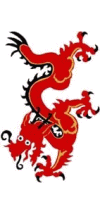
Step-By-Step Instruction
Following these simple steps will guide you through a complete consultation with the I Ching Online.
This page is a
Complete Manual for using the I Ching or "Yi Jing"
.Step 1
In the opening screen, enter your question in the text-box.You don't NEED to enter a question.
Writing it down is optional, but it helps your concentration on the issue if you formulate it in written form.
It will help you get your topic "in-the-air".
And it helps for printing purposes as well; you will better remember the reading when you print the answer together with the question, on paper.
When the page is closed, the question is gone into cyberspace.
Unless you save your reading in your personal account, of course, but then it is obvious that you write it down.
And even if you don't, you can still edit the question in your saved reading.
The more detailed the question, the more accurate the answer.
A vague question will invite a vague answer.
A tip for non-English-speaking visitors: Try to formulate your question in English; this will help you concentrate on the problem, and besides, will improve your English!
We suggest you try the online Google Translate.
Only ask serious questions; don't test the I Ching.
If you don't take the I Ching seriously, it will not work.
Do not ask yes/no-questions like "Should I quit my job NOW?" or either/or-questions like "Should I quit my job NOW, or should I stay?", because either way you ask two questions in one.
Better pose the question as: "What will happen if I quit my job NOW?".

Push the Continue button.
Step 2
Now you can choose between two methods for throwing coins.Throw coins virtually, or
Throw coins by hand
Nothing wrong with virtual coins, but if you insist on using your own real metal ones, you can do so by pushing the Throw coins by hand button and fill in the result of your cast by flipping the coins on the screen.
The coins flip when you click them.
When done, the Read button works the same for both methods.
The Throw coins by hand feature comes in very handy when you want to return to a former reading.
When you remember the pattern of lines, you can fill them in later, and see the answer again.
Either way, in case you did not enter your question satisfactorily, you can simply close the window, correct the question and click Continue again.
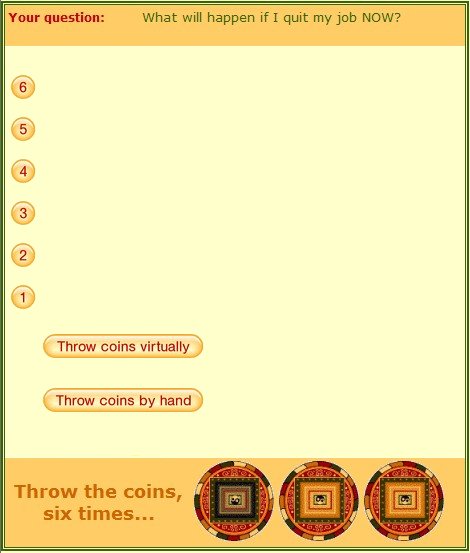
3a Click the Throw coins virtually button six times,
or
3b Click the Throw coins by hand button, and manipulate the coins on the screen by clicking them.
Step 3a
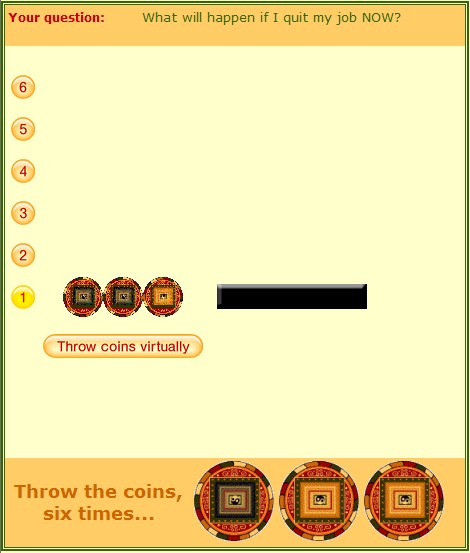
Step 3b
Throw three coins by hand, and fill in the result, by manipulating the coins on the screen.
Heads is yang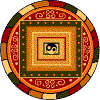 (light) and tails (or "writing") is yin
(light) and tails (or "writing") is yin 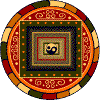 (dark).
(dark).
The first time you click a coin it will show yin (dark / tails).
(dark / tails).
With every further click, you will toggle between yin (dark / tails) and yang
(dark / tails) and yang  (light / heads).
(light / heads).
Every time you have thrown three real coins, fill in the result by clicking the coins in the screen until they match your cast.
You can manipulate the coins until you push the Read button, which will appear after you finished all six lines (= 18 coins).
Heads is yang
The first time you click a coin it will show yin
With every further click, you will toggle between yin
Every time you have thrown three real coins, fill in the result by clicking the coins in the screen until they match your cast.
You can manipulate the coins until you push the Read button, which will appear after you finished all six lines (= 18 coins).
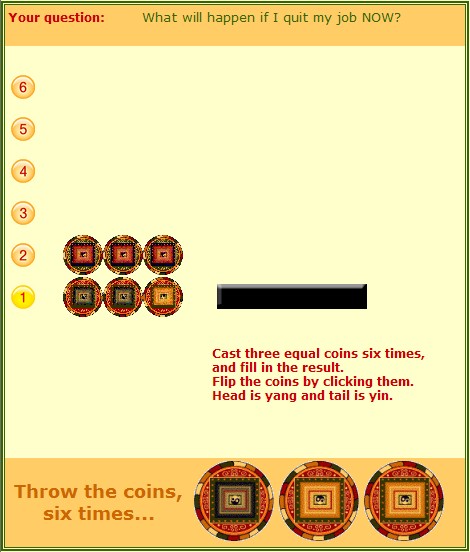
Every time you build a line, either by pushing the Throw coins virtually button, or when you chose the Throw coins by hand button, and filled in three coins, one hexagram line is built at a time, from the bottom up.
One side of the coin represents yin
Yin counts 2 and yang counts 3.
Throwing three coins at once makes four combinations possible:
|
2 yang, 1 yin (3+3+2)= 8 |
|
|
pure yin |
|
2 yin, 1 yang (2+2+3)= 7 |
|
|
pure yang |
|
3 yin (2+2+2)= 6 |
|
|
changing yin |
|
3 yang (3+3+3)= 9 |
|
|
changing yang |
|
|
A broken line represents yin. |
|
|
A solid line represents yang. |
|
If either a yin or yang line is red, that line is a changing line, which will transform into its polar opposite during the course of your consultation. |
|
|
|
A red broken line represents a yin line that transforms into a yang line. |
|
|
A red solid line represents a yang line that transforms into a yin line. |
Step 4

To advance to the interpretation, click the Read button.
Step 5
In the next screen, the Cast Hexagram tab appears.
With the Cast Hexagram begins the answer to your question, often explaining the situation you are now in, or what has gone before.
Step 6
Click the Changing Lines tab.
Changing Lines transform into their polar opposite during the course of your consultation.
When there are more than one lines changing, there is a problem in interpretation; if these lines are contradictory, which one to choose?
At I Ching Online we have chosen to apply a set of rules to determine the one changing line that prevails as an answer to your question.
This one Changing Line is selected initially, but you can read about any Changing (red) Line by clicking on it.
Changing Lines are part of the answer to your question, but any NON-changing (black) Line can be read as well by clicking on it.
(Clicking the Changing Lines tab again will reset.)
Although this set of rules is old and widespread, it is just one of many methods that can be found to handle this delicate issue.
Consider it a guideline, which is not compelling at all.
The following rules are applied for the seven possible number of changing lines:
0. |
There are no Changing Lines. |
Read only the Cast Hexagram. |
1. |
There is one Changing Line. |
Consult this changing line. |
2. |
There are two Changing Lines. |
If both lines are Six (Old Yin) or Nine (Old Yang), the Upper Line applies. If one is Six and the other Nine, the Six prevails (*). |
3. |
There are three Changing Lines. |
The middle line counts. |
4. |
There are four Changing Lines. |
Read the upper NON-changing line. |
5. |
There are five Changing Lines. |
Read the only NON-changing line. |
6. |
All lines are Changing. |
Only the Transformed Hexagram applies. With two exceptions: If all lines are Six or all lines are Nine, read both Cast Hexagram and Transformed Hexagram. |
|
*) The origin of the rule that an Old Yin prevails over an Old Yang when there are two changing lines is not known to us, but possibly it comes from the "yarrow stalk" method. The chances for the different hexagram lines to occur depend on the method used. At I Ching Online we use the 3 Coins method, where the chance for an Old Yin is equal to that for an Old Yang, but with the yarrow stalk method, the chance for an Old Yin to appear is three times more rare than for an Old Yang. It might be for this reason that an Old Yin prevails, simply because it is more "special" than an Old Yang. |
||
|
3 Coins method |
Yarrow Stalk method |
|
|
|
1 / 8 |
3 / 16 |
|
|
3 / 8 |
7 / 16 |
|
|
3 / 8 |
5 / 16 |
|
|
1 / 8 |
1 / 16 |
Of course the computer program applies the rules for you.
In our example there are two Changing Lines, a Six (Old Yin) and a Nine (Old Yang).
The Six (Old Yin) prevails.
In this case, the I Ching would consider quitting your job the wrong move:
"Self-discipline teetering toward self-destruction An empty martyrdom. Turn back."
Step 7
Click the Transformed Hex tab.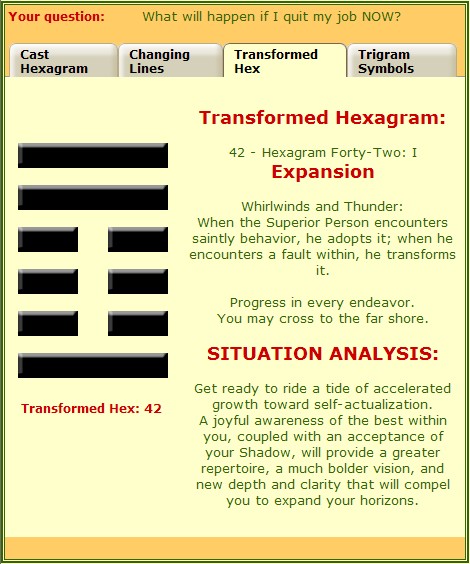
The Transformed Hexagram describes the future situation, after the lines have changed, and if you follow the advice the I Ching has given.
In our example, the accelerated growth of which the I Ching is speaking, you will surely experience when you do NOT quit your present job.
(Whether this will be IN your present job, or in any other situation that results from your not quitting, the I Ching does not say. Perhaps you will be fired anyway, and experience a rebirth under your own steam.)
If there are no Changing Lines, this Hexagram is equal to the Cast Hexagram.
Step 8
Click the Trigram Symbols tab to read the interpretation of the two Trigrams (based on King Wen) that the Cast Hexagram is made of.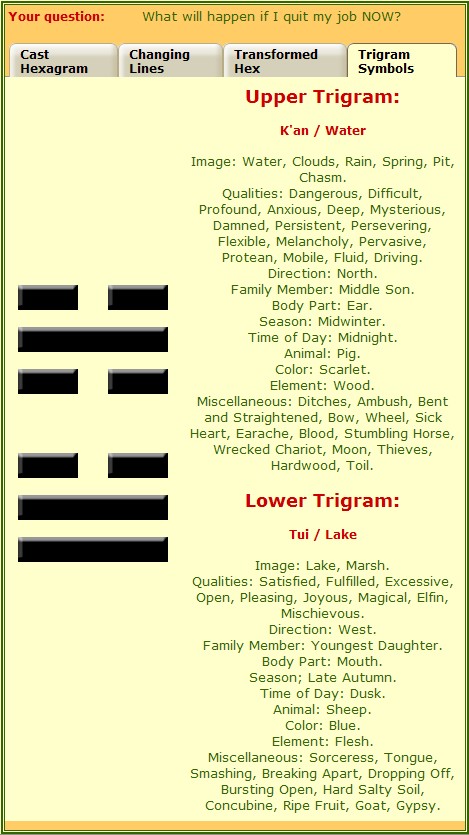
A Hexagram is made up of two Trigrams, one atop the other.
Only the Trigram Symbols of the Cast Hexagram are displayed.
A Trigram is made up of any combination of three yin and yang lines.
There are eight possible combinations, each with its own distinct attributes:
|
|
|
|
|
|
|
|
|
|
|
|
|
|
|
|
Ch'ien / Heaven
|
Chên / Thunder
|
K'an / Water
|
Kên / Mountain
|
|
|
|
|
|
|
|
|
|
|
|
|
|
|
|
|
K'un / Earth
|
Sun / Wind
|
Li / Fire
|
Tui / Lake
|
The Hexagram in our example is made up of the Upper Trigram K'an / Water, and the Lower Trigram Tui / Lake.
| Line | |||
| Upper Trigram: |
|
|
|
|
K'an / Water |
|
|
|
|
|
|
||
| Lower Trigram: |
|
|
|
|
Tui / Lake |
|
|
|
|
|
|
||
|
Hexagram 60: Chieh / Limitations |
There are 64 hexagrams in all, each representing an archetypal situation in life.
See page "About I Ching" as well.
Printing
Of course you can print your I Ching reading.Select the frame you want to print by clicking anywhere in it.
In the File menu of your browser choose "Print Preview".
At the top of the next screen you must see a drop-down box in the printing toolbar.
Choose "only the selected frame" and not "as laid out on screen".
